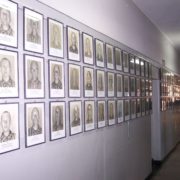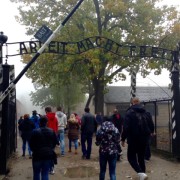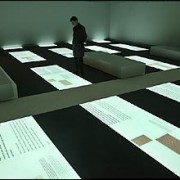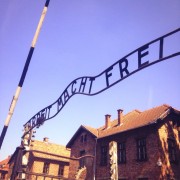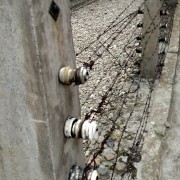Unexpected Connections to the Past
By: Kelsey Klimara
I could probably reflect on my trip to Auschwitz for days and still have more to say. I could also have spent more than a few days at the camp and still had more to see. Although six hours seemed like more than enough at the time, I don’t think that we even reached the tip of the iceberg when it comes to the distant mystery that is Auschwitz.
Our bus pulled up to a small building that advertised tickets, snacks and a water closet. It didn’t seem like a place of mourning much less a place of mass murder. I then saw students of all ages running around and gossiping, just as they would on any other field trip. Our group, which never seems to fall silent, was one of the most quiet and serious of them all.
We began our journey by viewing multiple barracks that once held the prisoners of Auschwitz. The majority of them have now been reconstructed as exhibits to display different aspects of the inner workings of the camp.
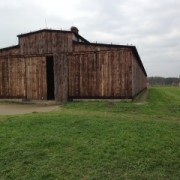 Next, we reached a building that held objects taken and left by prisoners during their stay. Entire rooms were dedicated to different things such as shoes, pots and pans, and children’s clothes. The most gruesome of all was the room that exhibited massive mounds of hair behind glass walls. These displays marked the first moment where I really realized that I was not just in a museum. I really had to tell myself that these shoes were once on a child’s foot. This hair was on an innocent human’s head. And above all, after their possessions were stolen, they were starved and worked to death. I was in a place where the scale of the tragedy makes it impossible for me to fully understand it.
Next, we reached a building that held objects taken and left by prisoners during their stay. Entire rooms were dedicated to different things such as shoes, pots and pans, and children’s clothes. The most gruesome of all was the room that exhibited massive mounds of hair behind glass walls. These displays marked the first moment where I really realized that I was not just in a museum. I really had to tell myself that these shoes were once on a child’s foot. This hair was on an innocent human’s head. And above all, after their possessions were stolen, they were starved and worked to death. I was in a place where the scale of the tragedy makes it impossible for me to fully understand it.
The size of the camp is what really struck me next. I could not believe how far the camp went on. We moved from Auschwitz to Birkenau for the second half of the tour and I figured that it couldn’t be much larger than the first part. I was so wrong. I thought that we had ended our second tour on three separate occasions. I could look out across the vast, open land, spotted with wooden barracks, and it seemed to be unending. Then I started to realize that the size is not even close to a fraction of the space necessary to hold the massive amount of innocent people that it did.
I believe that history most strongly resonates once a person is able to personally relate. Even if it is something minute, it is at least something tangible to grasp rather than a distant story. The impact of this space as a whole struck me personally at a point that may not resonate with many others.
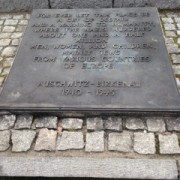 Throughout my life, I have studied and taught Catholicism. My church has always placed emphasis on the Catholic saint, Maximilian Kolbe, in particular. He has always been a figure in my life. I know his story and I knew that he was killed in Auschwitz but for some reason, I did not even think about the fact that I would see where he died during my visit. When our tour guide casually mentioned his name, I jumped.
Throughout my life, I have studied and taught Catholicism. My church has always placed emphasis on the Catholic saint, Maximilian Kolbe, in particular. He has always been a figure in my life. I know his story and I knew that he was killed in Auschwitz but for some reason, I did not even think about the fact that I would see where he died during my visit. When our tour guide casually mentioned his name, I jumped.
Maximilian Kolbe was a Franciscan priest who founded multiple friaries. The first was just outside of Warsaw and produced a daily newspaper. During the war, he worked with the other friars to organize shelter for 3,000 Polish refugees, 2,000 of which were Jews. The Nazis grew suspicious of his work and Maximilian Kolbe was taken as prisoner to Auschwitz. One day, when a prisoner escaped, the soldiers demanded 10 other prisoners die for his crime. Kolbe heard one of the ten chosen men pleading for his life and offered to take his place. Kolbe persevered for two weeks in the starving chambers before dying of lethal injection.
Next, we walked down into the starvation cells of Auschwitz and our guide showed us the spot where Maximilian Kolbe died. I was completely thrown off guard and struck emotionally. That entire experience proves to me that I did not realize the reality of this place. These were real people. Each one with their own story, and only a small portion of those are known. After feeling personally attached to that place, I started to think about my reaction. A saint’s place of death had such a strong impact on me, but so many others have direct connection to multiple people that were brutally murdered at Auschwitz. I almost felt selfish for my emotional reaction when I knew how much this place impacted others.
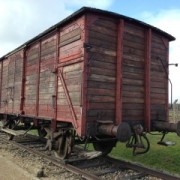 Once we had walked across this giant stretch of land, we returned to our bus and drove away. I started to notice all of the houses and communities in the surrounding area. Everything around this concentration and death camp looked completely normal. In fact, the land seems to have transformed into a normal neighborhood that contains a museum, but as a visitor it was completely shocking that anyone would live in an area with such a tragic history. In this place that has been transformed from the death camp that it once was, to a museum, it is easy to look past the depth of the story. It is easy to walk along and disregard the fact that this was once the reality. I think that the things that hit us the hardest are any of those things with which we personally identify. But the real task is to look at the bigger picture. Because the events that affect every single person on earth, those are the ones that should garner reaction in us the most.
Once we had walked across this giant stretch of land, we returned to our bus and drove away. I started to notice all of the houses and communities in the surrounding area. Everything around this concentration and death camp looked completely normal. In fact, the land seems to have transformed into a normal neighborhood that contains a museum, but as a visitor it was completely shocking that anyone would live in an area with such a tragic history. In this place that has been transformed from the death camp that it once was, to a museum, it is easy to look past the depth of the story. It is easy to walk along and disregard the fact that this was once the reality. I think that the things that hit us the hardest are any of those things with which we personally identify. But the real task is to look at the bigger picture. Because the events that affect every single person on earth, those are the ones that should garner reaction in us the most.



